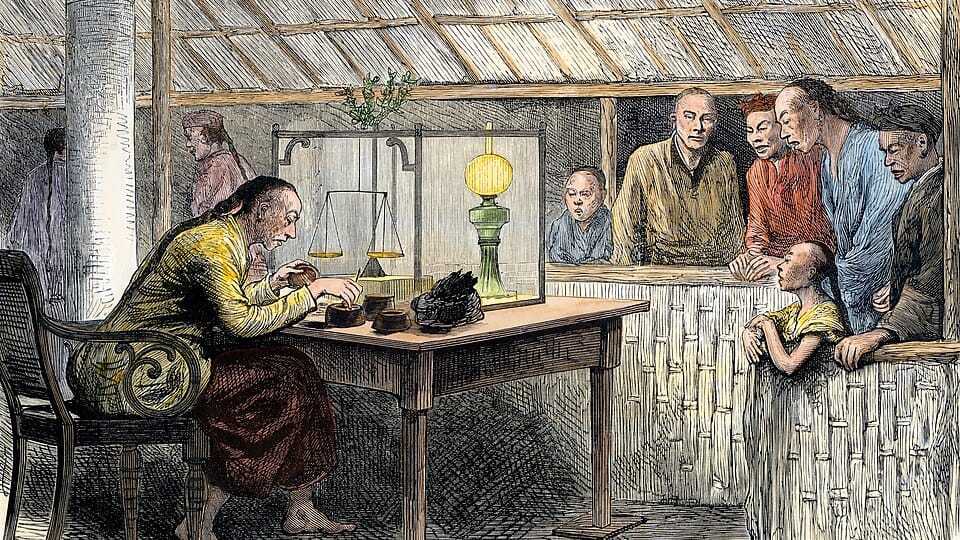America And The Chinese Merchant

The Chinese Merchant has been the most revered and feared force in the Far East for over a millennium. They are revered for their vast trade goods and products, but feared as agents of control and subjection. Throughout Southeast Asia, China projected its political control over countries like Korea and Vietnam by first utilizing the humble Merchant to infiltrate each society.
China must have been delighted when the richest prize of all, America, asked those Chinese merchants to come to us. Of course, that’s not how Americans saw it; that’s the Chinese perspective.
For the Americans, China represented just one more cog in the great American Global Hegemony. After fighting two proxy wars against China to a standstill, one in Korea and the other in Vietnam, Washington was ready to try a new strategy. President Richard Nixon and Secretary of State Henry Kissinger devised a “detente” with China, the American plan to welcome China into the twentieth century and the global community of nations.
U.S. leadership saw China as a backwater country needing American innovation and commercial prosperity. A new marketplace of US Products in which retailers like Sears Roebuck and Montgomery Ward would sell modern products like RCA Victor, Magnavox, or Hoffman color television sets, the very apex of American consumer goods. Once Chinese consumers experienced the delights of US-made products, they would become a marketplace for the ages, producing untold wealth and profits for American manufacturers.
It was the Chinese “pot-o-gold,” American political leadership and corporations have been buying into this dream ever since. That is until Donald J. Trump, the businessman turned US President from Queens, NY.
However, during the first half-century of America’s burgeoning detente with China, Washington treated the country as its benevolent colonizer, providing every benefit we could imagine for this “developing country.” Standards we considered essential were waived for China. Rumors of dangerous working conditions and even slave labor were brushed aside. Yes, it was true that Chinese workers endured long hours and subsistence wages, but that didn’t matter; China was “developing.”
Chinese factories are among the most environmentally damaging on earth, but no matter, “developing,” you know. At the height of irony, America sells China the very coal we deem too polluting to use in our own country.
Recently, China has been granted access to our capital markets to sell stock in America. Yet, almost none of those Chinese companies adhere to the same accounting standards as required of American companies, giving Chinese foreign corporations a significant advantage in raising capital, capital provided by American shareholders. At the latest count, nearly 5,000 Chinese companies are listed on American Exchanges, providing much-needed financial support for Chinese manufacturers and other commercial enterprises.
Add these all up: the lowered safety and compensation standards for workers, the non-existent environmental controls, and even the American financial support, and the result was an insurmountable cost advantage for the makers of Chinese goods. However, beyond the cost advantage, let’s not lose sight of the fact that the Chinese economic system is NOT a free enterprise system like the US. The Chinese System is an amalgam of State control and private initiative, in which the goals and objectives of the CCP take precedence over all else.
In just a few short decades, China had built an unconquerable “moat” to use a modern financial idiom, a price structure that American manufacturers could not match. Much of this advantage came from the regulations enacted in Washington, designed to promote the best of all conditions here. Still, ignoring the Geo-economic effect this would have on our trade with China. As American producers became more regulated, the Chinese cost advantage grew.
So, in a move that would make the 19th-century Robber Barons blush, China captured the American markets one by one. Low-priced goods, toys, and gadgets were among the first to move offshore. Walk down a toy aisle today, and you’d be hard-pressed to find a single American-made doll or game. Consumer electronics followed, and I dug up some old names of US television makes for this article. Eventually, high-tech, precision machinery, equipment, and electronics, such as smartphones, lab equipment, and medical devices, followed.
Consider this: Even if Chinese manufacturers were required to meet all the standards for workers, environment, and safety, they would still not pass the Sherman Antitrust Regulations, as China’s predatory pricing alone would disqualify them.
From Adam Smith onward, classical economists consider the ideal economy one in which the consumer and the producer are roughly equal. This ideal economy would involve a nation that produces nearly everything it needs, and the consumer purchases its products.
Today’s America is as far away from that ideal as is conceivable. The American consumer makes up 60–70% of all the economic activity in the nation. Not, as many espouse, because we’re the wealthiest buyers in the world. But because we have little production, the direct result of China moving our production offshore.
None of this is by accident. Through shrewd planning and a multi-generational perspective, China has utilized a “market capture” strategy that has subjugated millions over the centuries.
Today, the Chinese Merchant is winning. It’s time for America to meet its challenge.
**
If you enjoyed this article, please consider buying me a cup of coffee.
Go to:
https://buymeacoffee.com/davidreavill
Thanks for reading!